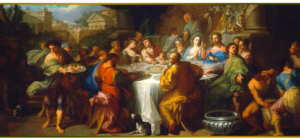The Wedding Feast at Cana
Oil on canvas
Giovanni Domenico Piastrini
This magnificent 18th-century Roman work may be a rare one by Giovanni Domenico Piastrini and betrays a strong connection to his teacher Benedetto Luti. Piastrini was arguably his best pupil, though very little survives to document his life or oeuvre. Some experts believe that certain passages (for example, the handling of the male figure at the left forefront of the table, the woman at the far right of the table, and the brushwork in the kneeling figure at the extreme right) are painted as if by Luti himself. Other portions, such as the bride and groom, betray a strong connection to the early work of Luti’s other student, Placido Constanzi. While Piastrini’s style is clearly dependent on that of his teacher and his fellow student, other elements of the painting are clearly of his own derivation.
Though so little is definitively known about the painting, the one surety is the subject. Piastrini illustrates the first of Jesus Christ’s miracles (though not a public one) at the wedding feast of a friend of the family. John’s Gospel (2:1-11) clearly says that Mary was present, and that Jesus and His disciples were invited. The distinction is subtle, but important to the story.
Mary seems to be especially close to the hosts, close enough to be concerned that the wine was gone, unlike a mere guest. So Mary goes to her Son with only a statement of the need; she sees no reason to spell out her request. She knows her son. Jesus’ calling His mother, “Woman,” may seem cold, but He addresses her the same way from the cross as He directs John to care for her, a tender act under horrific conditions. The question “What have I to do with thee?” may possibly be a rebuke, but only a very gentle one considering that He resolves her concern. He was here on earth to show that He was the Messiah, not to solve a banquet shortage. However, His relationship with His mother is such that she has utmost confidence in His compassion, even in situations of social crisis. Trustingly, she issues instruction to the servants, “Whatsoever He saith unto you, do it” (v. 5). Again, only a close friend would give another’s servants an order, especially of such an open-ended nature. Jesus may not have an obligation to solve the problem, but Mary apparently feels a responsibility to save her friends from embarrassment. And Jesus is touched with compassion for her.
Piastrini places Mary next to an older woman, probably the mother of the groom who is clearly enthralled with his bride. (And, she is apparently appreciative of her wedding necklace!) Mary’s eyes are downcast submissively (remember her submissive answer to Gabriel’s surprising news?), and her hands are in the classic pose of prayer. Perhaps Piastrini reflects the Catholic tradition of Mary as the intercessor to Christ for those on earth. She has certainly interceded for the hosts, but not in any way remotely connected to eternal salvation. It is doubtful that the artist’s rendering depicts the moment she asks her Son for help since the servants are posed to pour out the water-into-wine for the governor of the feast, according to Christ’s instruction.
The governor of the feast (in the green) is clearly discussing the matter of the empty wine vessel (made of fine silver to show the importance of the occasion). The servant on the left side reassures him that there is more wine ready to serve. No one else seems to be concerned, not even Mary—now. Presumably the stone water jars which now hold wine are too heavy to pour from, so the servant in the right foreground uses a smaller silver vessel to pour the beverage into the larger silver urn from which the serving pitcher can be filled.
John carefully relates that no one knows where the latest—and best—wine has come from. Except the servants. Christ has not revealed Himself to the general public for His “hour had not yet come.” But He did reveal Himself to the common man, as He always did in His ministry, finding in them a willingness to believe in His deity that the religious leaders of the day did not. Piastrini composes his work so that the common man and the miracle itself are in the foreground of the painting and thus, in the forefront of the viewer’s mind. Christ’s upraised hand in the iconic pose of blessing shows He not only blesses the feast with His provision, but also the marriage with His presence.
Whether by a single artist or as a collaboration, The Wedding Feast at Cana celebrates the early 18th-century Roman style. The brilliant coloration of fabrics, the monumental size (almost 6×12 feet!), the gestured poses of multiple figures, and the classical architecture serving as backdrop for the staged event all contribute to a masterful late Roman interpretation of this biblical banquet scene.
Karen Rowe Jones, M&G board member
Published in 2020
